Made in Slovenia
The Igor Zabel Award for Culture and Theory acknowledges the exceptional achievements of curators, art historians, theorists, art writers, and critics whose work supports, develops or investigates visual art and culture in Central, Eastern, and Southeastern Europe.
The award is named in honour of the distinguished Slovenian curator and art historian Igor Zabel (1958–2005). It has been conferred biennially since 2008 in cooperation with ERSTE Foundation (Vienna) and the Igor Zabel Association for Culture and Theory (Ljubljana). With total prize money of €76,000, it represents one of the most generous and prestigious awards for cultural activities related to Central, Eastern, and Southeastern Europe.
This year Zdenka Badovinac, the curator, art writer, and director of Ljubljana's Moderna galerija has been is named the Igor Zabel Award laureate. On 4 December 2020, at the biannual ceremony in Ljubljana, Badovinac will thus be awarded for her outstanding institutional leadership as the director of the Moderna galerija/Museum of Modern Art and the Museum of Contemporary Art Metelkova (+MSUM) in Ljubljana, as well as for her radical curatorial work and significant contributions as a writer and editor to international discourses on the geopolitics of contemporary art in Eastern Europe and global art history. Igor Zabel Award Grants will also be given to Slavcho Dimitrov, Katalin Erdődi, and Ivana Bago.
The award comes at an interesting time for Slovenian cultural institutions, which are currently under threat of new staffing arrangements to promote the current government’s agenda, with some NGOs also losing their premises in Metelkova, Ljubljana’s cultural quarter. And it’s in this politically charged context that the Igor Zabel Award 2020 jury has recognized Zdenka Badovinac as one of the most important and rigorous locally rooted and globally connected professionals in the field of cultural production in recent decades.
Badovinac became the director of Moderna galerija in Ljubljana in 1993. According to the jury, since she was appointed to this post, and through her curatorial innovations, Badovinac has made Ljubljana's Moderna galerija into one of the most progressive, critical, and referential art institutions worldwide. The jury also emphasized Badovinac's important contributions to new paradigms in art theory, the politics of art, curatorship, practices of exhibiting, institutional critique, and strategies of solidarity within the (institutional) contemporary art field. Her remarkable achievements prove that the subversive potential for radical change lies not only in professional expertise, but also in combining this expertise with personal devotion, a sense of solidarity, and a commitment to building alliances.
This year's Igor Zabel Award Grant recipients selected by the jury are:
Slavcho Dimitrov (Skopje), activist, cultural theorist, and curator, in recognition of his contributions to reimagining the cultural and social life of the Western Balkan region, and for bringing LGBTQIA+ and women's rights and struggles to the heart of that vision.
Katalin Erdődi (Vienna/Budapest), curator, dramaturg, and cultural worker, in recognition of her locally embedded and inclusive curatorial practice, distinguished by its scope as well as its critically reflexive and joyful qualities.
The third grant recipient was selected by the laureate.
This year Zdenka Badovinac selected Ivana Bago (Zagreb), curator, art historian, and art writer, in recognition of her excellence and insistence on the art historical research, writing, and exhibiting of Yugoslav and Eastern European art.
You can learn more about the award, and related events, at the official website. You can see more of Igor Andjelić's work here
KOBI – the Made in Slovenia App to Help Children with Reading Difficulties, in All Western Languages
Dyslexia week was in October, when this story was supposed to run, but take too much work, add a little kitten and set against a background of all the news in the world, and things get forgotten.
Luckily, the KOBI app isn’t a time limited offer, but a full made in Slovenia tool to help children with reading difficulties. Intended for those aged 6 to 12, it provides an essential suite of tools, including the proven technique of coloured letters, to help poor readers (re)gain confidence and independence, and learn to love the worlds opened up by books.
We got in touch with the team behind KOBI, and they were kind enough to answer our questions
What problem does the app address?
Reading is still the foundation of learning and everyday communication. Many intelligent children with reading difficulties fail to acquire sufficient reading fluency to succeed academically and even have problems in everyday life. Research has shown that a lot of psychological issues in children and even a large portion of minor suicides stem in learning difficulties. Moreover, when a child is not learning to read as expected this oftentimes becomes a source of conflict between the parents and the school, which leads to an even more stressful environment for the child.
Our clients are thus parents of children with moderate to severe reading problems between the ages of 6 to 12. The school system requires parents to read with their child, but does not direct them how best to do this.
And here we should not that we’re talking about children who don’t like to read. Reading is painful for them. Even short sessions often end with anger, stubbornness and tears. Their parents are looking for ways to motivate and make reading easier. There is still a stigma attached to the problem of learning to read, which is why parents and schools often wait until problems become intolerable.
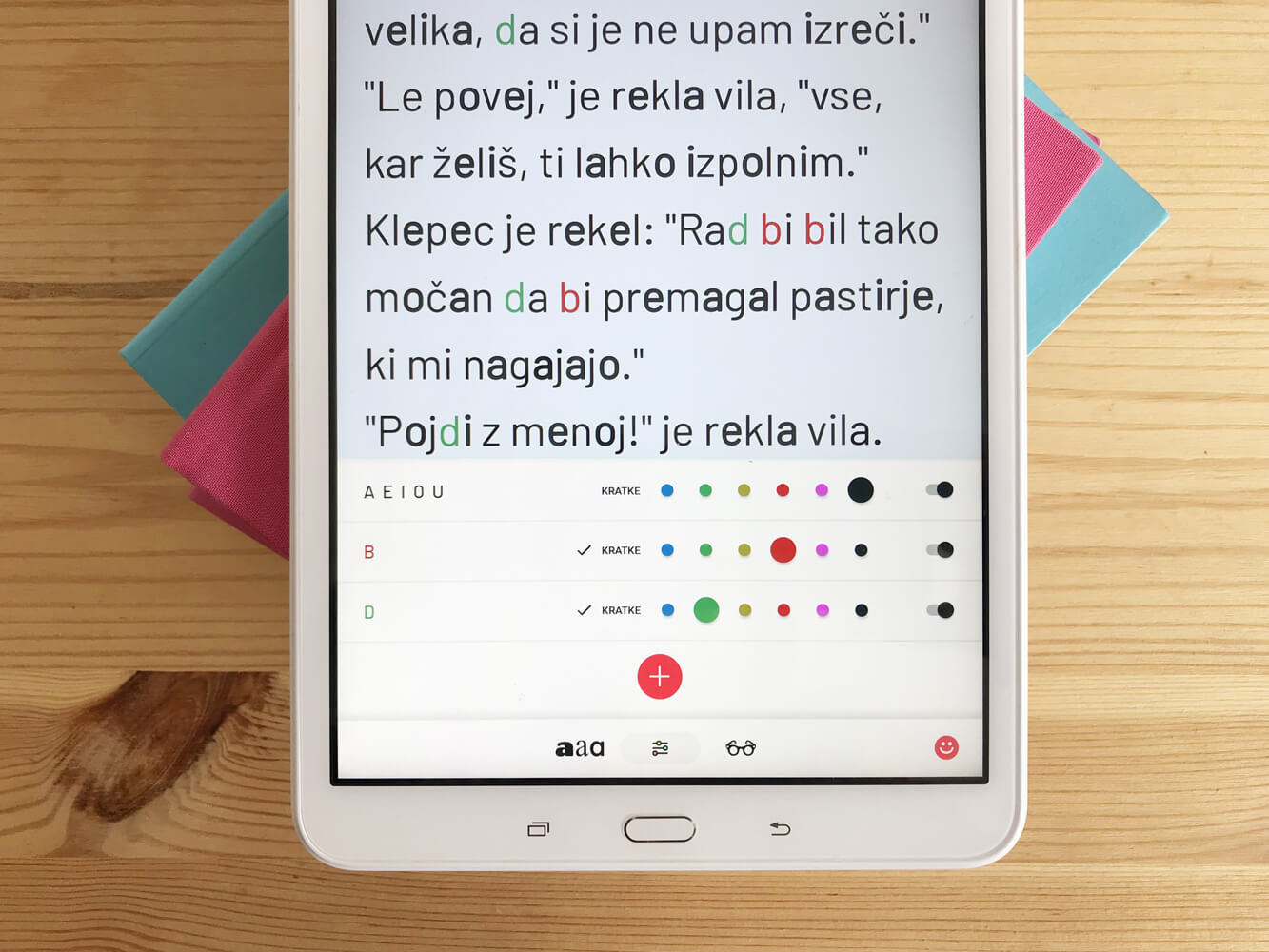
In contrast, we’re positioned in the “early aid” segment. Our solution does not require any diagnostics because it supports the learning process as it happens with all children. It therefore closes the gap between the first signs of problems and the conclusion of a typically long lasting diagnostic process.
Learning to read is a tough job. It requires a lot of repetition, training and patience. We believe that parents and educators must work hand in hand to support a child as long as it is necessary to gain this skill of life-long importance. And as any skill you only master it by doing it.
KOBI is focusing on reading connected text, which is a crucial part of the learning to read. Many parents cannot afford to hire a professional tutor and thus they are challenged to become reading tutors themselves. They need evidence-based, easy to use, efficient solutions, that can be adopted to any reading curriculum.
So how does KOBI it work?
KOBI is a mobile app. You install it on your phone or preferably tablet. You can pick a book from our growing library or simple take pictures of a book you have at hand. Then you let your child choose modifications of the text. The main feature of KOBI are the “coloured letters”.
By giving a certain colour to a letter or letter combination the brain receives additional sensory input that helps the child with some specific issues. For example, one of the things kids struggle with are so-called letter reversals. They mix up similar shapes such as b/d/p/q, u/n, e/a. However, with colours the brain can very quickly learn that a b is red, so the problem is solved. Since letter reversals are a developmental issue it will disappear with time, but in the meantime the use of colour will prevent a lot of frustration, and help the child to read more fluently.
KOBI also has tools such as focus frame and word-to-speech, and it tracks the reading practice. All these tools together help the child and keep them motivated, so they continue to improve
What special features does it have compared to the competition?
Overall, the key advantage of KOBI is its mix of functionalities and the fact that it can be used to support any school curriculum. Selective colouring of letters is one of the unique features, and while the interface is in four languages – English, Slovene, Spanish and Dutch – but you can import books in any western language. The interface that’s used by the child is completely icon-based, and can be easily operated by a seven year old.

How is it being used in the real world?
In Slovenia KOBI has already been widely adopted by special education teachers and, of course, parents. Abroad it’s mainly used in a home setting to help with reading practice, required reading materials or simply to adjust any materials that the child would like to read but the print is not suitable. The letters are too small, for example.

What feedback have you had from users?
Users tell us that KOBI is a game changer for children who struggle with letter reversals, as well as lack of motivation for reading. Parents get very emotional when they see that their child can not only suddenly read, but wants to read. Still, the secret of success here is perseverance and grit. Learning to read requires a lot of practice, especially for kids, even with the support of technology.
Who works at the company?
There are four cofounders. Andrej Peršolja, with a background in journalism and who is responsible for content and growth, Marko Fornazarič, our all-round developer, Auke Touwslager, designer and visionary, and Ursula Lavrenčič, a designer who five years ago took a deep dive into the pedagogics of reading.

What's next for KOBI?
We have many goals ahead. We are working on the next big update of the product, putting in everything we have learned. We are fine-tuning the business model and target number one is to get a foothold in English-speaking markets. Our mission is to build a product that will be in the toolkit of every family of a child who struggles with learning to read, and to help them become enthusiastic, independent readers.
You can find out more about the app, and download it for Apple or Android devices, here, with the website offered in English, Slovenian, Spanish and Dutch. You can also follow the project on Facebook
STA, 29 October 2020 - Stories from the Chestnut Woods (Zgodbe iz kostanjevih gozdov), an award-winning debut by director Gregor Božič, has been selected by a group of experts as Slovenia's submission for a nomination for best international feature film award at the 93rd Oscars, set to be held on 25 April 2021.
The Union of the Associations of Slovenian Filmmakers believes that the film, which premiered at the 2019 Toronto International Film Festival, captures a timeless, almost archetypal spirit of Benečija, an area in eastern Italy populated by ethnic Slovenians.
Stories from the Chestnut Woods brings to life a poetic nature of the region, telling the stories of people "who are still defiantly inhabiting the remote borderlands, as well as ubiquitous traces and memories of all those who have already left in pursuit of their wish for a better tomorrow", reads the justification.
Božič's debut is an outstanding work boasting brilliant cinematography, scenography and sound effects and creating a dream-like rhythm to depict a specific area, said the experts. It speaks to the universal need in individuals to leave places frozen in time, they added.
"Božič displays a mature and at the same time fresh and in-depth understanding of film narrative, a characteristic seldom seen in debut films."
Stories from the Chestnut Woods, a Slovenian-Italian co-production, written by Božič and Marina Gumzi, also the film's producer, was filmed between 2012 and 2019. It is a fusion of dreams, phantasms and recollections portraying a disintegration of a small community near the Slovenian-Italian border after the Second World War.
The film bagged most Vesna Awards last year, Slovenian equivalents to Oscars, including the award for best film, best director and the audience's darling.
It also recently won the jury prize for best film at the Nara International Film Festival in Japan as well as the critics prize at the CinEast festival of Eastern and Central European film in Luxembourg.
RTV Slovenia currently has the whole film online, in Slovene with Slovene subtitles
STA, 26 October 2020 - The Stigma safe house for women users of illicit drugs marked its 10th anniversary this year. Neva Faninger and Sabina Zorec, social workers working at the house, have told the STA that the facility is a shelter for women who have fallen through the cracks in the social system.
The safe house was set up by the Ljubljana-based Stigma association, which aims to mitigate damage done by drug use. The shelter strives to be something similar to a home where women can put life on the street behind them.
It is one of the few such facilities in the world, and the only one in Slovenia, that does not expect its residents to be completely drug-free when they enter the programme.
The organisation however endeavours to keep the house as drug-free as possible. In the facility and its surrounding area drug use is banned, said Zorec and Faninger. Any illicit drugs brought to the house have to be put away and placed in special lockers.
The association came up with the idea for the shelter having seen how many women who were caught in a vicious circle of drug use and violence had nowhere safe to go, most notably released women prisoners. Their families were often a source of problems and did not provide a safe space.
Stigma stepped in and has since housed women with various stories, including those who do not have a drug problem but have ended up in a situation where the house was their only option.
"The system is rigid, everyone has their own fief and wants specific users, whereas people are complex," said Zorec, calling for a more flexible approach that would acknowledge people's different stories and needs.
"Recently, we admitted a girl who just turned 18. The moment she came of age, she arrived at the house from a youth crisis centre. She does not have an acute drug problem, but her only options were the safe house or the streets," said Zorec, noting that the shelter does not admit minors.
The average age of the residents is 37. Aside from drug use, homelessness and experiences of street or domestic violence, one thing they usually have in common is trauma. They were often either victims of child abuse or sexual abuse later in life. Lack of education and mental disorders are also frequent characteristics of the residents.
"A behavioural disorder label is considered a consequence of drug use, although it is often the other way around," said Zorec.
"They make up for that as much as they want and can in the house," said Faninger, adding that education is the best way out of the vicious circle, even though for many it is also the most difficult path. Residing in the house can be a stepping stone for shelter programmes that require complete abstinence though.
Women may stay at the house for a year and a half with the possibility of extension. Since 2016 the organisation also has two support flats of the Ljubljana housing fund at its disposal for residents who have achieved a certain level of stability.
Zorec and Faninger have noted certain changes during the past ten years; there are more young residents who are barely adults and new psychoactive substances have emerged. Ten years ago, heroin was the drug of choice, now anything that is available counts as long as it serves the purpose of escaping reality.
"Drugs are a way of survival for them, they mitigate struggles that usually stem from childhood," said Faninger.
The facility can admit up to eight women, however the number has recently been reduced to seven since one room has been turned into a potential quarantine space in the event one of the residents is infected with the coronavirus.
Due to the shelter's high hygienic standards, there has been little need to additionally ramp up disinfection efforts since the outbreak, said Faninger.
The safe house hosts workshops and endeavours to get its residents involved in volunteering or to find them work. The staff accompanies and supports them during doctor visits, court hearings or when maintaining contact with their children.
Seven persons are employed at the 24-hour shelter, including three men, which has turned out to be a positive feature. Women can thus see that not all men are perpetrators of violence. The staff members are of different educational backgrounds, ranging from social workers and graduates in comparative literature to engineers.
Discrimination and a social stigma are common features experienced by the residents. Even the staff are often a target of discrimination, especially when they accompany or assist the women in the outside world, said Faninger, adding that prejudices are present among experts as well.
Marking the 10th anniversary, the organisation decided to release a publication by the residents to present the project and show that there are positive aspects, opportunities to change for the better.
You can learn more about Stigma at the group’s website
STA, 19 October 2020 - Slovenian writer Goran Vojnović has received the Angelus Central European Literary Prize, conferred to works by Central European writers translated into the Polish, for his 2013 novel Yugoslavia, My Fatherland (Jugoslavija, moja dežela).
The annual award is conferred by the Polish city of Wroclaw to writers who take up the most important topics for the present day. It comes with a cheque for 150,000 Polish zloty (roughly EUR 33,000). The translator, Joanna Pomorska, received a 20,000 zloty (EUR 4,400) cheque.
According to the portal Polish News, the jury short-listed seven titles out of 105 entries for the final stage of the award.
The chairman of the jury, Mykola Riabczuk, emphasised that the books that made it to the final selection were "very Central European".
He said each of them had a history that continues. The jury ended up deciding between two books that were both about war and voted four to three for Yugoslavia, My Fatherland.
Vojnović, who attended Saturday's ceremony via video call, said Angelus was "undoubtedly the most important recognition I have ever received."
He noted that past laureates and this year's nominees were among authors whose avid reader he is. "Just being in their company has been an exceptional honour."
The novel talks about a young man searching for his father, who turns out to be a war criminal.
It received the Kresnik Prize for best Slovenian novel in 2013.
Interview with Goran Vojnović: Writer & Filmmaker, Gateway to Contemporary Slovenian Culture
STA, 8 October 2020 - Two years after the end of World War I, a Slovenian minority would end up on the other side of the Karawanks following a plebiscite in Carinthia that determined the border between Austria and the Kingdom of Serbs, Croats and Slovenes. While the outcome of the vote was the product of several factors, what followed was a period of revanchism.
The plebiscite was held on 10 October 1920 under the provisions of the Treaty of Saint-Germain, signed a year earlier by the allied powers that won World War I on the one hand and the Republic of German-Austria on the other.
While parts of Carinthia now in Slovenia (Meža Valley and Jezersko) were to be incorporated into the Kingdom of Serbs, Croats and Slovenes, the fate of southern Carinthia down to the Klagenfurt basin was to be determined by a plebiscite, under the principle of self-determination championed by US President Woodrow Wilson.
Before the vote, the Klagenfurt basin was divided into two zones; Zone A in the south with a predominately Slovenian speaking population and the smaller Zone B, which comprised Klagenfurt and its surroundings. Zone B was to hold a referendum only if a majority of voters in Zone A would have opted for what had already at the time been known as Yugoslavia.
However, with the turnout at almost 96%, 22,025 ballots or 59.04% of the vote cast was in favour of Austria, against 15,279 or 40.96%, who opted for Yugoslavia.
In their 2003 textbook, historians Dušan Nećak and Božo Repe estimate that at least 10,000 Carinthian Slovenes voted in favour of Austria, while some historians estimate a majority of the Slovens eligible to vote opted for Austria.
Despite having posted military victories ahead of the plebiscite, the Slovene side suffered a diplomatic defeat at the Paris peace conference and another one at the ballot box.
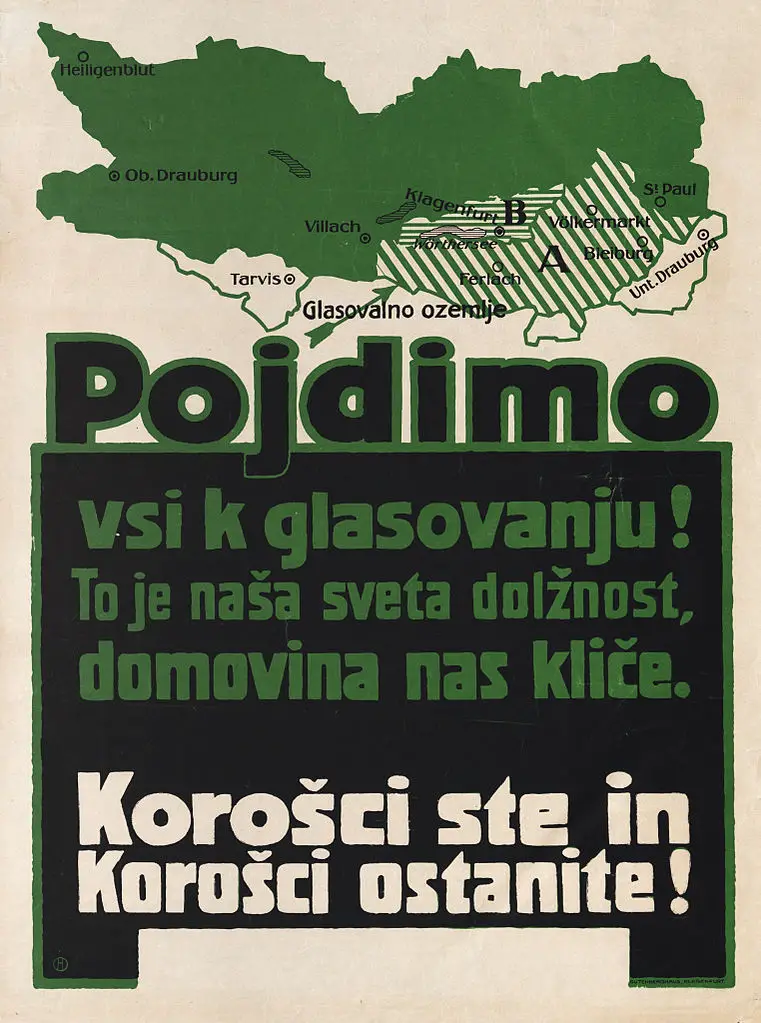
Poster in Slovene ("Let us go and vote! It is our sacred duty, our homeland is calling us. You are Carinthians, and you should remain Carinthians!"), featuring zones A and B. (Wikipedia)
A mix of factors and interests decided the outcome
Historian Andrej Rahten, a former Slovenian ambassador to Austria, says that several factors were at play in the outcome of the plebiscite, however the battle for Carinthia had already been lost during the Habsburg monarchy.
"Even before World War I, Slovenians in Carinthia saw an adverse demographic trend, going from one quarter of Carinthia's population in the 1900 census by speaking language, which was biased methodologically, to a good fifth in 1910, and then, in the first post-plebiscite census in 1923, to one tenth."
Rahten, talking with the Slovenian and Austrian press agencies, STA and APA, in a joint interview, says the key role in the decision for the plebiscite was played by US President Thomas Woodrow Wilson.
If it had not been for France's support of Yugoslavia, the demarcation would have been even more harmful for Slovenians, he says; if you asked the Americans, they would have assigned Carinthia north of the Karawanks to Austria even without a plebiscite.
This was because of the belief that Austria, which had to accept secessions of some other border territories with practically no referendum rights, should be given some territorial concession lest it should become part of some great Germany.
Rahten believes the plebiscite result would have been very different had it not been for the Karawanks mountain range, which represented not only a physical but also a psychological barrier.
"The decisive element was economic reasons"; for centuries Klagenfurt and Villach had been traditional markets for Carinthian farmers, while now they were supposed to be replaced by Ljubljana.
Similarly, British historian Robert Knight offers economic interests as one possible explanation why Slovenians opted for Austria, along with the appeal, or lack thereof, of Yugoslavia with respect to Catholicism or the monarchy.
The Austrian propaganda played an important role; it emphasised economic benefits of the undivided Klagenfurt basin, regional identity, links between Slovenian- and German-speaking inhabitants and the cultural differences between Catholic Austria and Orthodox Serbia as the leading nation in Yugoslavia.
Historian Tamara Griesser-Pečar, in one of her articles, also notes the significance of the Carinthian Slovenians' attachment to their land, as well as social, economic, religious and political reasons and their bad experiences with the Yugoslav authorities.
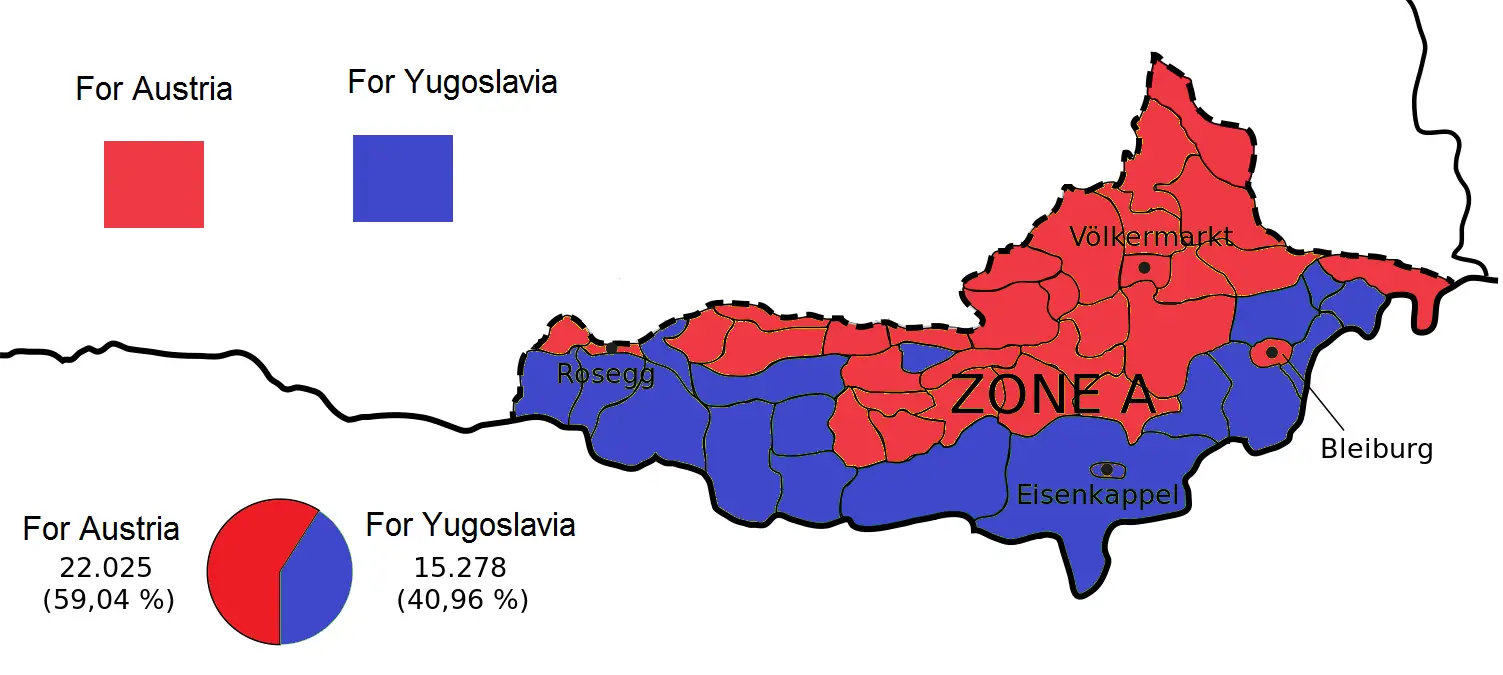
The results by municipality. Paasikivi CC-by-SA-4.0
After plebiscite, broken promises and revanchism
A vital factor why Slovens opted for Austria would have been Austria's pledge to protect the minority's rights, passed by the provincial assembly in Klagenfurt in September 1920.
However, as early as 25 November 1920, Arthur Lemisch, the head of the province's provisional government, publicly advocated in the provincial assembly for Carinthian Slovenians to be Germanised within a generation.
The nationalist sentiment in Austria only grew between both world wars, resulting in further assimilation of Carinthian Slovenians. It was not until 1955 that they had their rights guaranteed in the Austrian State Treaty but they are yet to fully enjoy them.
Rahten and Knight, a historian from University College London who has studied the fate of Carinthian Slovenians, have talked to the STA and APA about the dark period in the wake of the plebiscite, about revanchism, persecution and scaremongering.
The Slovenians who voted for Austria were expected to assimilate, become German, while the others had to be induced to move south through a mixture of "pressure, persuasion and structural coercion", says Knight.
There were also opposing forces as for example in Social Democracy, "but by and large, Carinthian politics was also aimed at intolerance, exclusion and ethnic homogenization", although Knight does not see that as something distinctly Carintihan.
"The plebiscite definitely made the tensions only worse and it took decades, through change of generations, for those first months of revanchism to be gradually and slowly put behind," Rahten says.
He notes physical assaults on people accused to have voted for Yugoslavia, even if they may have not, arson attacks on the homes of Slovenian patriots, and the perpetrators going punished.
Before the plebiscite, Carinthian officials had been promising that no one would be hurt, that everyone would enjoy equal rights, that Slovenians would be better off than in the old Austria, but just the opposite happened.
"The promises were soon broken. What followed soon after can simply be called revanchism (...) which led to the Slovene elite being driven out of Carinthia," says Rahten, noting that an estimated 3,000 refugees fled Carinthia after the plebiscite.
At the same time, "the political impotence when it came to protection of the Slovene minority's rights in Carinthia was offset by very harsh measures taken against the Germans who were left in Yugoslav Slovenia", such as forced Slovenisation of German schools.
Centenary celebrations in a buoyant mood
The relationship between the majority and minority in Austrian Carinthia had begun to mend only after Slovenia declared independence in 1991 where Austria played a key role in the country's international recognition.
Like in the case of the Slovenian minority in Italy, the atmosphere for the minority in Carinthia improved further after Slovenia joined the EU in 2004 and the Schengen area three years later.
Knight, noting that the centenary celebrations appear to have taken a different course after neglect of the Slovenian minority and its language in the past, believes the main emphasis of commemoration of 1920 should be on honouring the promise made publicly on the eve of the vote, that is to preserve the minority's unique identity.
STA, 29 September 2020 - The Technology Park Ljubljana (Tehnološki park Ljubljana) a tech, startup and scaleup community that involves over 300 member companies, innovative teams, and individuals, is celebrating its 25th anniversary.
The project, whose first contours were drawn at the Jožef Stefan Institute (IJS) in 1994, has helped develop a number services that have consolidated Slovenia's position on the map of technological innovation.
While more than 1,500 people are connected to its work, the centre itself employs 18 people and is a non-profit organisation.
Its biggest owner is the Ljubljana municipality, while other owners include the IJS, the Chemical Institute, the National Institute for Biology, as well as telecoms equipment maker Iskratel, electronics company Iskra and pharma company Lek.
The main fields of interest are automation, biotechnology, medicine, digital media, finance, industrial technology, information and communication technology, creative industries, the environment and energy, trade and life sciences.
Announcing the celebration plans, Technology Park Ljubljana director Jernej Pintar has told the STA the focus will not be on ceremonies but on presenting new services and products and highlighting the importance of technology for everyday life.
Pintar argued the global success of the companies involved was testimony to the good work of the Technology Park Ljubljana. He pointed to the potential harboured by cooperation, highlighting a recent effort to manufacture a ventilator as an example.
"We hadn't produced them in Slovenia, we also did not know much about them, so we basically started from scratch," he said, explaining a working prototype was developed to the surprise of everyone involved in only three weeks.
"This is an unbelievable demonstration of how erudite Slovenian engineers are what we can achieve when we join forces," Pintar said.
Among future goals, he noted that development achievement also need to turn into business products. "In Slovenia this still happens too rarely. Those who did succeed have shown its possible."
Pintar moreover announced a project involving mentorship for students by some of the world's leading experts, as well as the launch of three co-working spaces in Ljubljana.
This autumn will see the launch of a brand-new sustainable food retail and travel brand, CULTISAN. A digital and mobile platform on a mission to enable a global audience to discover, buy, learn from, travel to, meet and eat with the world’s best farmers and makers, curated by the chefs who love them, driving a new sustainable global food economy.
The brains behind Cultisan is British chef, restaurateur and food campaigner Jason Hartley, now based in Slovenia, who aims to give a voice to the hundreds of farmers, growers and producers he has met around the world throughout his career. Cultisan was inspired by his deep belief that ethical farming that is kind to the land and animals is the only sustainable way to produce delicious food, and the realisation that there are 570 million small scale and family-run farms in the world that still feed 70% of the planet on a daily basis.
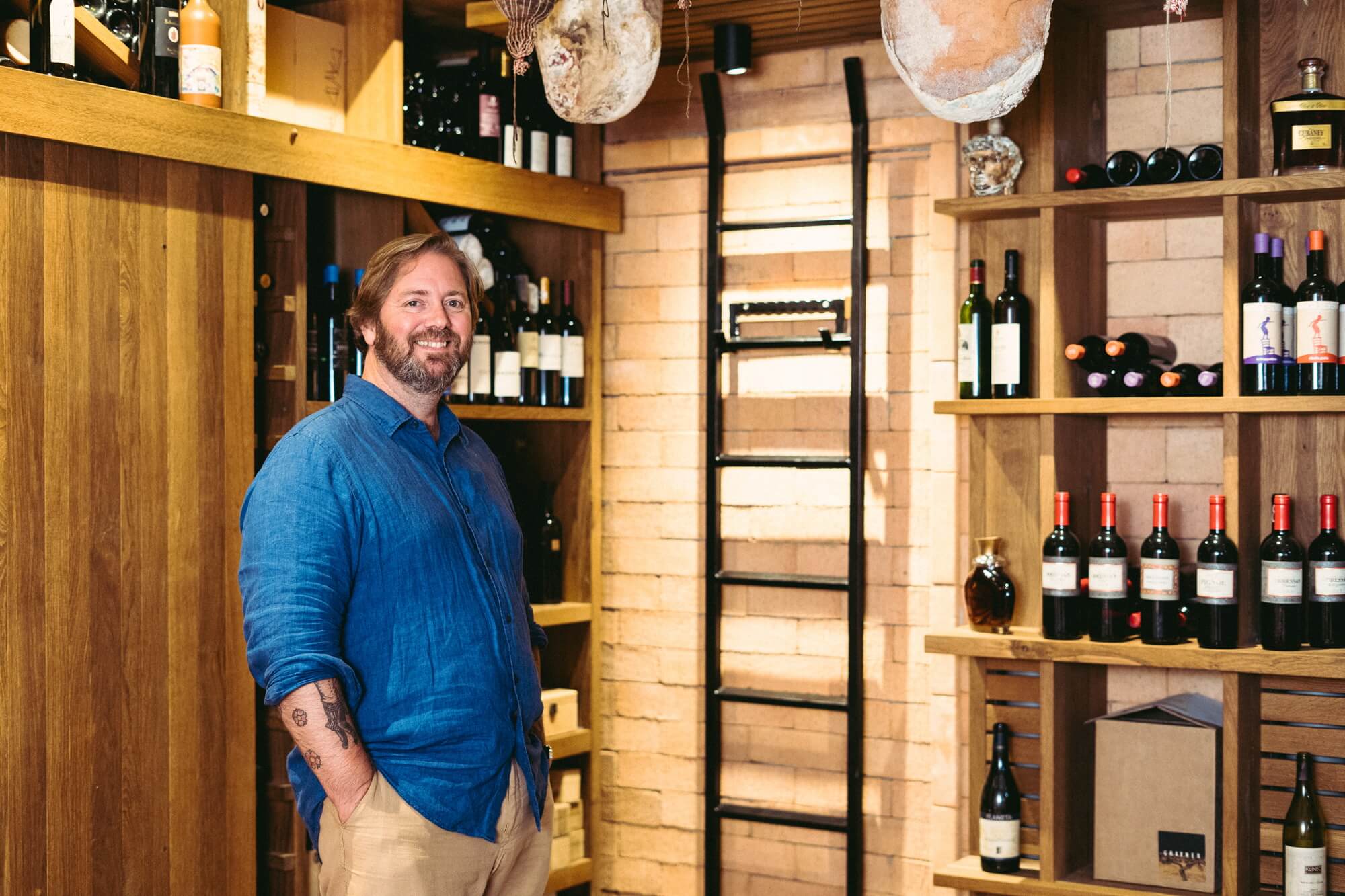
Jason says, “This is about making it convenient for people to eat local, anywhere. I want people to discover and buy from the world’s greatest farmers and producers as easily as they buy from supermarkets, it’s about championing the cheesemakers, curers, fermenters, millers, charcutiers, oil and vinegar makers and more. This is about a new fair food system ensuring the survival of craft, knowledge and talent of generations of farmers, and about celebrating the innovators and creators of the food world, making sure they’re still here for future generations.”
Cultisan is a membership platform and anyone can become a member (further details below). The crowdfunding campaign will be launched on Wednesday 23rd September and will run for one month before the official launch in November.
There will be no easier way to curate a shopping basket than with Cultisan. At its core lies the principle of not charging farmers, makers or producers any money to be listed on the platform and ensuring they are paid a fair price for their produce. By purely seeking out the very best in the world, with the help of leading chefs, Cultisan is making ‘eating local, globally’ a reality.
Set to be the world’s largest directory, the farms are chosen by the Cultisan team and a handpicked group of chefs predominantly in Europe, but the team already has plans to grow into other continents in 2021. These chefs have the inside track to the very best farms, suppliers, vineyards, growers and more, and Cultisan is bringing this to the consumer for the first time.
Cultisan will provide a global platform to smaller, more remote artisans such as Andrew Gilhespy at Fresh Flour in Devon, who works closely with a network of local organic farmers to grow heritage grains which are milled using a traditional stone ground method and turned into exquisite quality flour. They also champion producers who are growing their business without compromise, such as Northern Irish husband and wife team Richard and Leona Kane whose Broighter Gold rapeseed oil is some of the purest across the whole United Kingdom.
Across Europe, other unique growers, producers and farmers will be given an online platform on Cultisan’s app and website including a multitude of organic vineyards and olive groves throughout Italy. Closer to home for Jason, undiscovered Slovenian producers will be accessible to a wider market, including goat farmer, Peter Gorišek whose small batch goat’s cheese is stuffed with Istrian truffle and other more modern and innovative producers such as David Lesar’s biodynamic salami.
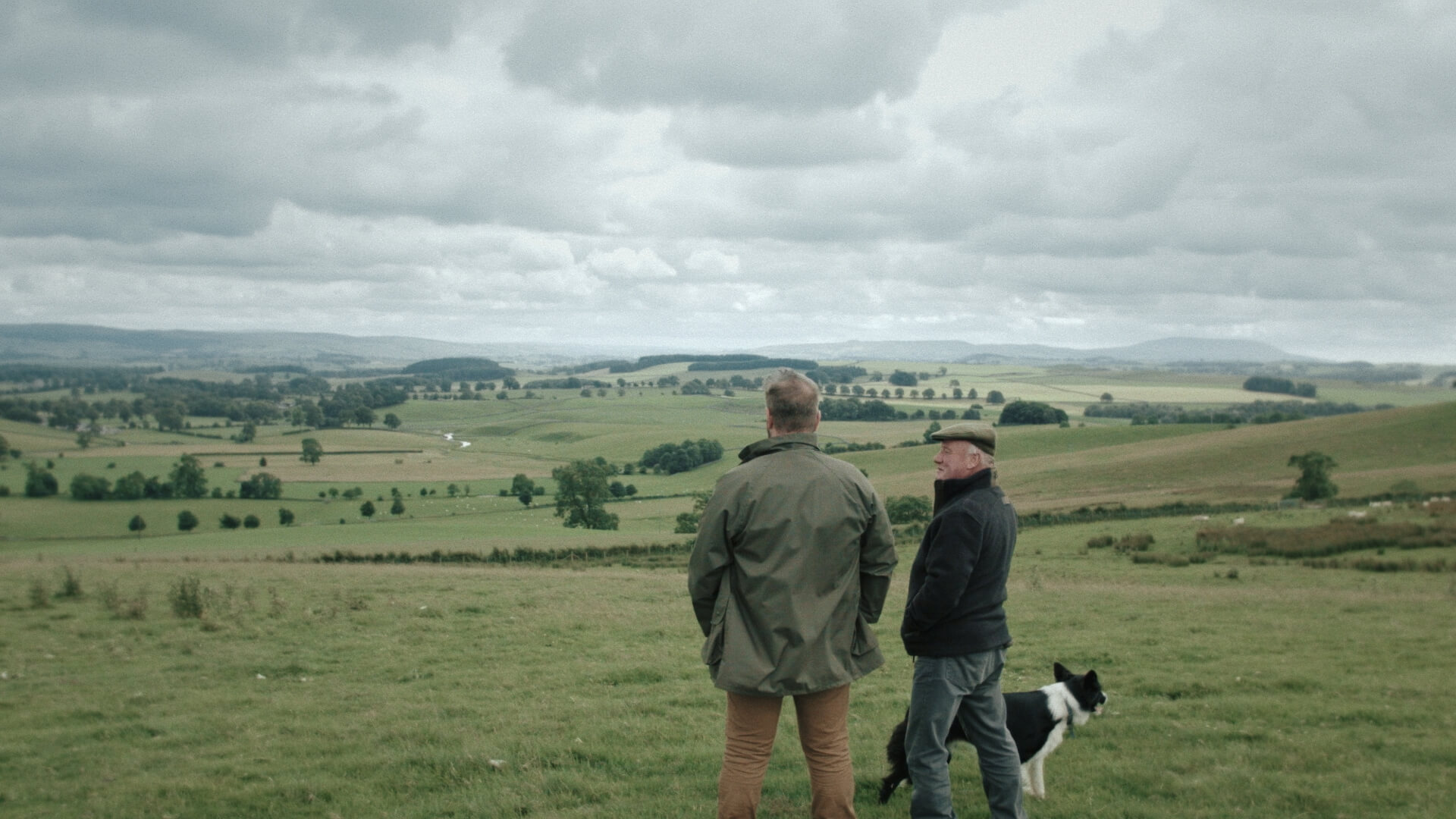
Cultisan has created local hubs on farms in regions across Europe and aggregates local produce before sending it to its logistic and fulfilment centres where it is packed and shipped to the consumer. Cultisan is dedicated to creating as sustainable a supply chain as possible, never shipping fresh food across borders and only moving foods between countries if a product offers something different and appealing to a consumer in that market.
Cultisan is enabling the public to shop, have delivered to their door and eat the very best produce local to them, and from further-afield. Cultisan will also offer unique food adventures that will make it possible for people to travel, meet, learn and eat with the finest farmers, makers and chefs whilst exploring new culinary cultures.
CROWDFUNDING Ahead of the launch of Cultisan in November, there is an opportunity to be part of the development and growth of the brand by joining the Kickstarter application. Cultisan is a membership platform. The membership being just £10 a month, or £120 a year (annual subscriptions receive free shipping). The 30 day Kickstarter will offer a range of pledges including annual membership discounts locked in for life, such as a first day only £75 offer including a tasting pack of products and a designer Tote bag, Kickstarter memberships of £95 and the chance for EU consumers to pre-buy memberships for when Cultisan open in their country from January 2021. There is also an opportunity to enjoy a private dinner party hosted by Cultisan founder Jason Hartley as well as the chance for a group of 4 to join him on an exclusive food adventure to Slovenia next year. |
Remember the wooden statue of Melania Trump that was commissioned by the American artist Brad Downey and handcrafted by Aleš Župevc, the one got burned down, just like the one of her husband?
Now vandals will have to rely on dynamite or a tow truck to remove the intriguing figure, which has been returned to its pedestal in Rožno, a hamlet about 8 km outside Melania’s hometown of Sevnica, in a new, more resilient bronze form, along with a plaque that reads “dedicated to the eternal memory of a monument to Melania which stood at this location”.
The bronze reproduction of the original is said to have cost Brad Downey around 10,000 euros, and - like the wooden version - has not been met with universal acclaim. A spokesperson for the Municipality of Sevnica, while expressing thanks for the publicity Melania Trump has generated for area, added that although artistic expression is "the free will of each individual, as long as it does not interfere with the dignity of another individual, but...the sculpture that has been erected, removed and now re-erected does not reflect these values. Even worse, it is completely inappropriate, and we believe that opinion is shared by the majority of the residents of Sevnica. In addition, the Municipality of Sevnica is associated with this project completely involuntarily, as the installation area actually lies outside its borders."
If you’d like to see more of Downey’s work then you’re in luck, as until 30 September 2020 you can visit a retrospective of his work in Koper with the title “Fuck off Illusion”. It can be found in Libertas, the former salt warehouse in Koper, with more details here.
STA, 15 September 2020 - The Ljubljana Faculty of Mechanical Engineering and the Guangdong University of Petrochemical Technology (GDUPT) have agreed to build an institute to research intelligent manufacturing methods of advanced materials in Guangdong Province, China.
According to the Faculty of Mechanical Engineering, the Advanced Material Intelligent Manufacture Research Institute (AMIMRI) is to be set up by 2023 in a joint effort.
Last week, the Faculty of Mechanical Engineering of Ljubljana and the Guangdong University of Petrochemical Technology signed an annex to the cooperation agreement they signed in 2018.
They committed to transferring existing knowledge between Slovenian and Chinese academic and industrial environments, building an experimental laboratory on the site of AMIMRI, the establishment of a doctoral study of mineral wool technologies, the establishment of joint Slovenian-Chinese research projects and the publication of the new institute's research results in scientific articles and patents.
According to the faculty, they also plan to research the mineral wool market in China and establish networks with new companies, which will be able to achieve a significant improvement in technology development in cooperation with the AMIMRI.
The Chinese partner has committed to provide EUR 300,000 for the work of Slovenian researchers over a period of three years, as well as EUR 250,000 for the material costs of building the institute.
The Faculty of Mechanical Engineering added that representatives of two manufacturers of mineral wool insulation products were also present at the virtual signing of the annex last Wednesday, and they expressed great interest in cooperation.
STA, 11 September 2020 - The legendary Slovenian band Laibach will perform at Ljubljana Castle for the first time ever to celebrate its 40th anniversary. The organisers had to reduce the capacity of the courtyard to the allowed 500 visitors due to Covid-19 safety measures, so the band added an extra concert on Saturday, which was also sold out.
According to the Ljubljana Castle website, the Laibach concert was planned as the opening event of the Dragon Festival, a traditional three-day event on the castle hill. Due to the current situation, most of the planned programme had to be cancelled or postponed to 2021. However, the Laibach concert marking the 40th anniversary of the band will go through as planned.
Laibach is one of the most famous and recognized Slovenian bands, well established on the international alternative or independent music scene. In its musical expression, Laibach combines different genres, from an experimental industrial sound to symphonic "militant" classicism and electronic music, the organisers wrote.
Laibach is the principal founder of the retro-avant-garde art movement in Slovenia, along with other groups from the art movement known as Neue Slowenische Kunst. Since its beginnings, the band has been creatively combining music with other media at live performances.
"Due to their uncompromising artistic attitude, as well as penetrating analysis of the political ideology of totalitarianism, Laibach had faced many difficulties, and between 1983 and 1987 the band was officially banned in Yugoslavia and Slovenia," the organisers recalled.
Ticket holders will also have access to a limited series of calendars for 2021 with 12 illustrations of the band members intertwined with photographs of Ljubljana Castle.






